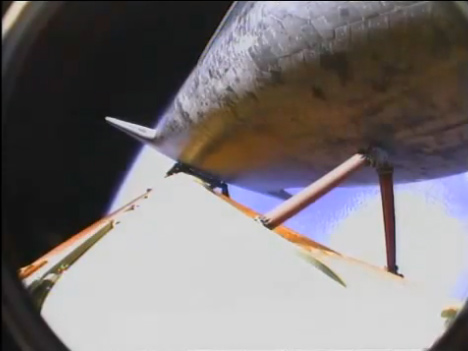Camera Glitch Should Not Impact Shuttle Mission, NASA Says

This story was updated at 6:53 p.m. EDT.
A camera glitch that occurred while astronauts were inspectingthe space shuttle Atlantis' heat shield Saturday shouldn't cause any overallnegative impact to the mission, a NASA official said.
The six-man crew aboard shuttle Atlantis spent Saturday ? theirfirst full day in space after launchingFriday afternoon ? scanning the orbiter's sensitive insulation tiles toensure they were not damaged during the liftoff.
While checking out the shuttle's inspection boom ? a longpole tipped with sensors used for the scan ? theastronauts had trouble moving the camera used to record data. After hoursof troubleshooting, they discovered that a cable connected to the sensor camerawas pinched in a piece of hardware on the shuttle. The glitch forced the crewto revert to a backup camera normally used during a later inspection.
Although theissue slowed down the normally six-hour inspection considerably, itultimately shouldn't harm the mission or its objectives, STS-132 lead shuttleflight director Mike Sarafin said Saturday.
Atlantis is slated to catch up to the International SpaceStation Sunday at 10:27 a.m. EDT (1627 GMT) to begin a weeklong stay to delivera new Russian lab and spare supplies.
"The crew is proceeding towards rendezvous and dockingtomorrow as planned," Sarafin said.
Get the Space.com Newsletter
Breaking space news, the latest updates on rocket launches, skywatching events and more!
Sensor trouble
The original camera intended for the scan has a wider fieldof view and contains its own light source. With that sensor system unusable,the astronauts opted to use a second sensor camera that takes more detailedimages. However, that camera has no light source so could only be used whileAtlantis was flying over the daylight side of Earth.
"It's kind of a mixed bag," Sarafin said of the cameraswap. "We have a little bit better coverage using the planned camera butit's higher-resolution imagery using the camera we used today."
Given the slower pace of today's inspection, the astronautswere not able to completely scan all the areas of the shuttle that theyplanned. In particular, they had to stop before the finished inspectingAtlantis port, or left-side, wing. They plan to cover that area using theregular camera attached to the end of the shuttle's robotic arm, after Atlantisdocks with the space station.
"We can get adequate scans and imagery of that entireportion of the port wing since it's on the same side as the shuttle roboticarm," said Atlantis' Mission Management Team co-chair LeRoy Cain.
In addition, more data on Atlantis'heat shield will be gathered when the shuttle flies in a planned back flip asit approaches the space station to allow astronauts stationed there to snapphotographs of its underbelly and sides.
"Once we get all that imagery on the ground the teamwill determine if we need to get additional information? or if we've got all ofwhat we need," Sarafin said.
If necessary, astronauts can undertake a second, morethorough inspection of the shuttle's heat shield during their fifth day in space,when some time has been set aside for the purpose.
Space debris
Another issue that came up was a possible threat from apiece of stray space debristhat appeared to be headed toward the International Space Station.
"We know that this object is there but we don't knowthe source of it," Sarafin said. "And we know that it's going to comein relatively close proximity to the International Space Stationtomorrow."
Space junk, such as used rocket parts, broken satellite bitsand other trash, poses a serious risk of impacting spacecraft and causingdamage, since both it and any vehicle in orbit are moving at extremely highspeeds.
Ultimately, mission managers determined that this particularpiece of debris is not a threat to the station, so they decided not to maneuverthe orbiting laboratory to avoid it. Even if the station had had to move, itlikely wouldn't have significantly impacted Altantis' plans to dock tomorrow.
- How Much Junk is in Space?
- Gallery - Last Launch of Shuttle Atlantis
- Rare Weekend Sky Show: Shuttle Atlantis, Venus, the Moon and Space Station
SPACE.com is providing complete coverage of Atlantis'STS-132 mission to the International Space Station with Senior Writer ClaraMoskowitz and Managing Editor Tariq Malik based in New York. Click here for shuttlemission updates and a link to NASA TV.
Join our Space Forums to keep talking space on the latest missions, night sky and more! And if you have a news tip, correction or comment, let us know at: community@space.com.

Clara Moskowitz is a science and space writer who joined the Space.com team in 2008 and served as Assistant Managing Editor from 2011 to 2013. Clara has a bachelor's degree in astronomy and physics from Wesleyan University, and a graduate certificate in science writing from the University of California, Santa Cruz. She covers everything from astronomy to human spaceflight and once aced a NASTAR suborbital spaceflight training program for space missions. Clara is currently Associate Editor of Scientific American. To see her latest project is, follow Clara on Twitter.









